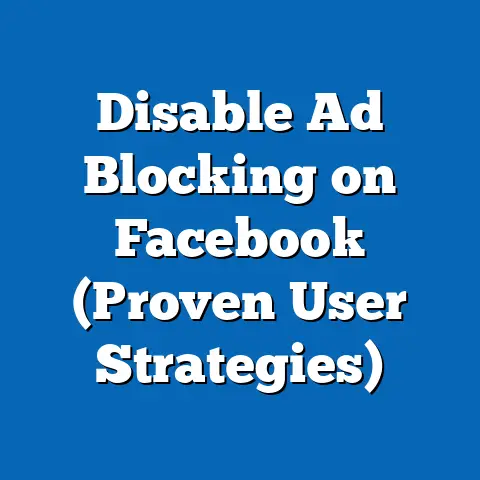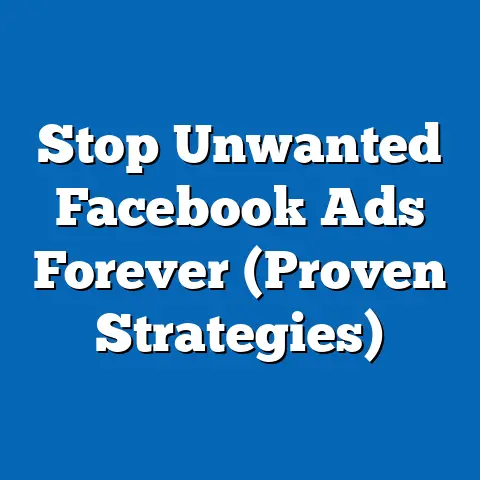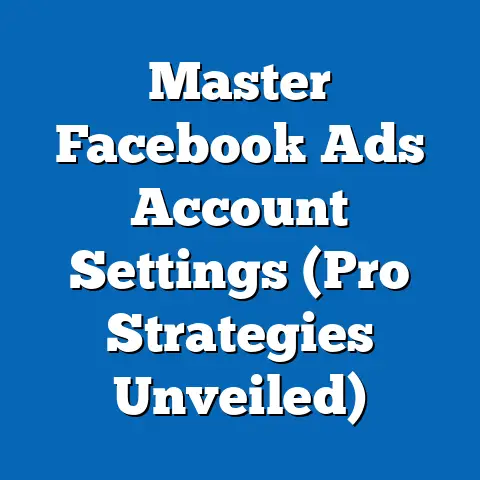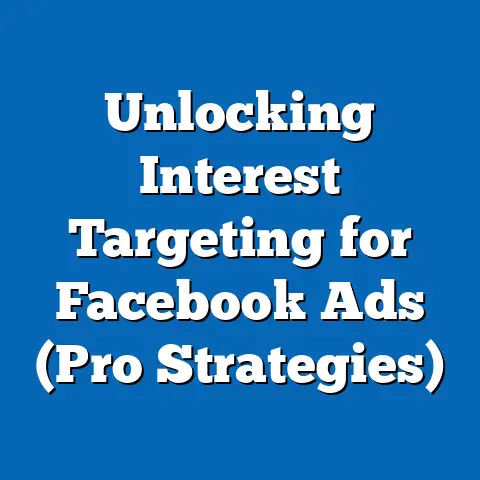Boost Sales with Facebook Shopping Ads (Proven Strategies)
I remember when my own family was younger, the holidays always felt like a joyful whirlwind. We’d spend hours browsing stores, trying to find the perfect gifts. My kids would point at everything, their eyes wide with wonder. It was chaotic, but filled with love and laughter. However, times have changed. Families today are juggling busy schedules, the constant pull of technology, and the ever-present need for convenience. That’s why finding the right products efficiently has become so crucial. And that’s where Facebook Shopping Ads come in! They’re not just ads; they’re a way to connect families with the products they need, at the moment they need them.
Understanding Facebook Shopping Ads
Facebook Shopping Ads are a powerful tool that allows businesses to showcase their products directly to potential customers within the Facebook platform. Think of them as virtual storefronts that appear right in the newsfeeds of your target audience. Instead of just seeing a regular ad, users see a visually appealing display of your products, complete with images, prices, and descriptions.
Unlike traditional ads that require users to click through to your website, Shopping Ads enable them to browse products and even make purchases without ever leaving Facebook (or Instagram, since they’re both part of Meta). This seamless shopping experience is a game-changer, especially for busy families who value convenience.
Different Formats for Different Goals:
Facebook Shopping Ads come in several formats, each designed to achieve specific marketing objectives:
-
Carousel Ads: These ads allow you to showcase multiple products in a single ad, with users able to swipe through the images. I’ve found them incredibly effective for highlighting a range of products within a specific category, like “Back to School Essentials” or “Summer Family Fun.”
-
Collection Ads: This format combines a hero image or video with a selection of related products displayed below. It’s perfect for creating a curated shopping experience, like showcasing an entire outfit or a complete room decor set. Think of it as a digital catalog, right in the palm of their hand!
-
Dynamic Ads: These are personalized ads that automatically show products to people who have expressed interest on your website, in your app, or elsewhere on the internet. This retargeting strategy is incredibly powerful because it reminds potential customers about products they’ve already considered, increasing the likelihood of a purchase. Imagine a parent browsing for a specific toy on your website, then seeing that same toy featured in a dynamic ad on Facebook – it’s a gentle nudge that can lead to a sale.
Carousel Ads: These ads allow you to showcase multiple products in a single ad, with users able to swipe through the images. I’ve found them incredibly effective for highlighting a range of products within a specific category, like “Back to School Essentials” or “Summer Family Fun.”
Collection Ads: This format combines a hero image or video with a selection of related products displayed below. It’s perfect for creating a curated shopping experience, like showcasing an entire outfit or a complete room decor set. Think of it as a digital catalog, right in the palm of their hand!
Dynamic Ads: These are personalized ads that automatically show products to people who have expressed interest on your website, in your app, or elsewhere on the internet. This retargeting strategy is incredibly powerful because it reminds potential customers about products they’ve already considered, increasing the likelihood of a purchase. Imagine a parent browsing for a specific toy on your website, then seeing that same toy featured in a dynamic ad on Facebook – it’s a gentle nudge that can lead to a sale.
The Visual Appeal Advantage:
For family-oriented consumers, visual appeal is paramount. High-quality images and videos that showcase products in a relatable, family-friendly context can significantly impact engagement and conversion rates. Think about it: a picture of a child happily playing with a toy, or a family enjoying a meal prepared with your product, is far more compelling than a generic product shot.
The Numbers Don’t Lie:
Statistics consistently demonstrate the effectiveness of Facebook Shopping Ads in driving sales. According to recent studies, businesses using Shopping Ads have seen an average increase of 20% in conversion rates and a 15% reduction in cost-per-acquisition. These numbers are even more impressive for brands that focus on family-oriented products, as families are highly active on social media and responsive to visual advertising.
Takeaway: Facebook Shopping Ads are a versatile and effective way to reach family-oriented consumers. Understanding the different formats and leveraging visual appeal can significantly boost your sales.
Next Step: Let’s dive into the nitty-gritty of setting up your own Facebook Shopping Ads.
Setting Up Your Facebook Shopping Ads
Okay, so you’re convinced that Facebook Shopping Ads are worth exploring. Great! Now, let’s walk through the step-by-step process of getting everything set up. Don’t worry, it’s not as daunting as it might seem. I’ll break it down into manageable chunks.
1. Creating a Facebook Business Account:
If you don’t already have one, the first step is to create a Facebook Business Account. This is separate from your personal Facebook profile and provides you with the tools and resources you need to manage your business’s presence on Facebook.
- Go to business.facebook.com and click “Create Account.”
- Follow the prompts to enter your business information, including your business name, email address, and website.
- Once your account is created, you’ll need to add your Facebook Page (if you have one) or create a new one.
2. Setting Up Your Facebook Catalog:
Your Facebook Catalog is essentially your online product inventory within Facebook. It’s where you’ll upload all the details about your products, including images, descriptions, prices, and availability.
- In your Business Manager, navigate to the “Catalogs” section.
- Click “Create Catalog” and choose the “E-commerce” catalog type.
-
Select how you want to add products to your catalog:
- Manual Upload: This option is best if you have a small number of products and want to add them individually.
- Data Feed: This option allows you to upload a spreadsheet or CSV file containing your product information. It’s ideal for businesses with a larger inventory.
- Pixel: This option allows you to automatically add products to your catalog based on data collected by your Facebook Pixel on your website.
- Partner Platform: If you use an e-commerce platform like Shopify, WooCommerce, or BigCommerce, you can connect your store directly to Facebook. I highly recommend this option as it simplifies the process and keeps your product information synchronized.
Select how you want to add products to your catalog:
- Manual Upload: This option is best if you have a small number of products and want to add them individually.
- Data Feed: This option allows you to upload a spreadsheet or CSV file containing your product information. It’s ideal for businesses with a larger inventory.
- Pixel: This option allows you to automatically add products to your catalog based on data collected by your Facebook Pixel on your website.
- Partner Platform: If you use an e-commerce platform like Shopify, WooCommerce, or BigCommerce, you can connect your store directly to Facebook. I highly recommend this option as it simplifies the process and keeps your product information synchronized.
3. Choosing the Right Products:
Not all products are created equal when it comes to Facebook Shopping Ads. You want to feature items that are most likely to resonate with family shoppers.
- Toys and Games: These are always a popular choice, especially during holidays and birthdays.
- Clothing and Accessories: Family-friendly clothing, matching outfits, and accessories are great options.
- Home Essentials: Products that make family life easier, such as kitchen gadgets, cleaning supplies, and organizational tools, can be highly effective.
- Groceries and Food Items: Consider featuring family-sized portions, healthy snacks, or meal kits.
- Educational Products: Books, learning toys, and educational resources are always in demand.
4. Writing Compelling Product Descriptions:
Your product descriptions are your chance to sell your products to potential customers. Make sure they’re clear, concise, and persuasive.
As I mentioned earlier, visuals are crucial for Facebook Shopping Ads.
- Use high-quality images: Make sure your images are clear, well-lit, and visually appealing.
- Showcase your products in use: Feature images of families using your products.
- Use video: Video is a great way to capture attention and showcase the benefits of your products.
- Optimize for mobile: Most people will be viewing your ads on their mobile devices, so make sure your visuals are optimized for smaller screens.
The Importance of a Well-Organized Product Catalog:
Think of your product catalog as the backbone of your Facebook Shopping Ads. A well-organized catalog makes it easier for Facebook to understand your products and show them to the right people.
- Use accurate product titles and descriptions.
- Categorize your products logically.
- Include all relevant product attributes, such as size, color, and material.
- Keep your catalog up-to-date with accurate pricing and availability information.
Takeaway: Setting up your Facebook Shopping Ads involves creating a Business Account, setting up your product catalog, choosing the right products, writing compelling descriptions, and creating eye-catching visuals. A well-organized product catalog is essential for success.
Next Step: Let’s talk about targeting the right audience to ensure your ads are seen by the families most likely to be interested in your products.
Targeting the Right Audience
You could have the most amazing products and the most visually stunning ads, but if you’re not showing them to the right people, you’re wasting your time and money. That’s where Facebook’s powerful targeting capabilities come into play. I’ve seen firsthand how precisely targeting your audience can dramatically improve your ad performance.
Understanding Facebook’s Targeting Options:
Facebook offers a wide range of targeting options that allow you to reach specific demographics, interests, and behaviors. Here’s a breakdown of some of the most relevant options for targeting family-oriented consumers:
- Demographics: Target users based on age, gender, location, education, relationship status, and parental status. For example, you could target parents with children of a certain age group.
- Interests: Target users based on their interests, such as parenting, family activities, children’s clothing, toys, and games.
- Behaviors: Target users based on their online behavior, such as purchasing habits, travel patterns, and device usage. For example, you could target users who have recently purchased baby products online.
- Connections: Target users who are connected to your Facebook Page or who are friends with people who are connected to your Page.
- Custom Audiences: Create custom audiences based on your existing customer data, such as email lists or website visitors. This is a great way to retarget people who have already shown interest in your products.
- Lookalike Audiences: Create lookalike audiences based on your existing custom audiences. This allows you to reach new people who are similar to your best customers.
Audience Segmentation Strategies:
To maximize the effectiveness of your targeting, it’s important to segment your audience based on specific criteria. Here are a few examples:
- Parents of Young Children: Target parents with children aged 0-5 years old who are interested in baby products, toys, and parenting advice.
- Parents of School-Aged Children: Target parents with children aged 6-12 years old who are interested in school supplies, extracurricular activities, and family travel.
- Families with Teenagers: Target parents with teenagers who are interested in fashion, technology, and college preparation.
- Grandparents: Target grandparents who are interested in gifts for grandchildren, family vacations, and senior activities.
Successful Targeting Examples:
Let’s look at a few examples of how businesses have successfully targeted family-oriented consumers using Facebook Ads:
- A children’s clothing retailer targeted parents with children aged 2-5 years old who were interested in organic clothing and sustainable products. They saw a 30% increase in sales compared to their previous targeting strategy.
- A family travel agency targeted families with school-aged children who were interested in all-inclusive resorts and theme park vacations. They generated a 25% increase in leads and a 15% increase in bookings.
- A toy company targeted grandparents who were interested in classic toys and educational games. They saw a 40% increase in sales during the holiday season.
Leveraging Lookalike Audiences and Retargeting:
- Lookalike Audiences: This is one of my favorite targeting strategies. By creating a lookalike audience based on your existing customer list, you can reach new people who are likely to be interested in your products. Facebook uses its sophisticated algorithms to identify users who share similar characteristics and behaviors with your best customers.
- Retargeting: Retargeting is the process of showing ads to people who have already interacted with your website or Facebook Page. This is a highly effective way to re-engage potential customers who have shown interest in your products but haven’t yet made a purchase. For example, you could retarget people who have viewed specific product pages on your website or who have added items to their shopping cart but haven’t completed the checkout process.
Takeaway: Targeting the right audience is crucial for the success of your Facebook Shopping Ads. Use Facebook’s targeting options to reach family-oriented consumers based on demographics, interests, and behaviors. Leverage lookalike audiences and retargeting strategies to re-engage potential customers.
Next Step: Now that you know how to target the right audience, let’s talk about crafting compelling ad copy and visuals that will capture their attention and drive conversions.
Crafting Compelling Ad Copy and Visuals
You’ve got the right audience in your sights, now it’s time to craft ad copy and visuals that will grab their attention and entice them to click. Remember, you’re competing with a constant stream of content in the Facebook newsfeed, so your ads need to stand out.
The Power of Storytelling:
Storytelling is a powerful way to connect with family shoppers on an emotional level. Instead of just listing the features of your products, try to tell a story about how they can improve the lives of families.
- Focus on family values: Emphasize the importance of family, love, and togetherness.
- Highlight everyday experiences: Show how your products can make everyday life easier and more enjoyable for families.
- Use relatable characters: Create characters that your target audience can identify with.
- Evoke emotions: Use language that evokes feelings of happiness, joy, and nostalgia.
Persuasive Ad Copy Tips:
- Use strong verbs: Verbs like “discover,” “create,” “explore,” and “enjoy” are more engaging than passive verbs.
- Highlight the benefits: Focus on how your products will improve the lives of families.
- Use social proof: Include testimonials, reviews, and ratings to build trust and credibility.
- Create a sense of urgency: Use phrases like “limited time offer” or “while supplies last” to encourage immediate action.
- Include a clear call to action: Tell people exactly what you want them to do, such as “Shop Now,” “Learn More,” or “Get Started.”
The Significance of High-Quality Visuals:
As I’ve said before, visuals are critical for Facebook Shopping Ads. High-quality images and videos can capture the attention of family-oriented consumers and communicate the benefits of your products more effectively than text alone.
- Use professional-quality images: Make sure your images are clear, well-lit, and visually appealing.
- Showcase your products in use: Feature images of families using your products in a natural and relatable setting.
- Use video to tell a story: Create videos that showcase the benefits of your products and connect with family values.
- Optimize for mobile: Make sure your visuals are optimized for smaller screens.
Examples of Successful Ads:
Let’s look at a few examples of ads that effectively combine compelling copy and visuals:
- An ad for a family board game featured a photo of a family laughing and playing the game together. The ad copy highlighted the benefits of spending quality time together and creating lasting memories.
- An ad for a meal kit delivery service featured a video of a busy mom preparing a healthy and delicious meal in minutes. The ad copy emphasized the convenience and time-saving benefits of the service.
- An ad for a children’s clothing retailer featured a photo of children wearing stylish and comfortable clothing. The ad copy highlighted the quality and durability of the clothing.
Takeaway: Crafting compelling ad copy and visuals is essential for capturing the attention of family shoppers and driving conversions. Use storytelling, persuasive language, and high-quality visuals to connect with your target audience on an emotional level.
Next Step: Once your ads are live, it’s important to track their performance and make adjustments as needed. Let’s talk about analyzing performance and optimizing your ads for maximum results.
Analyzing Performance and Optimizing Ads
You’ve launched your Facebook Shopping Ads, now what? It’s not a “set it and forget it” kind of thing. To get the best results, you need to track your ad performance, analyze the data, and make adjustments as needed. I’ve learned that even small tweaks can have a significant impact on your ROI.
Key Performance Metrics:
Here are some key performance metrics to track the success of your Facebook Shopping Ads:
- Impressions: The number of times your ad was shown to users.
- Reach: The number of unique users who saw your ad.
- Click-Through Rate (CTR): The percentage of users who clicked on your ad after seeing it.
- Conversion Rate: The percentage of users who completed a desired action (such as making a purchase) after clicking on your ad.
- Cost Per Click (CPC): The average cost you paid for each click on your ad.
- Cost Per Acquisition (CPA): The average cost you paid for each conversion.
- Return on Ad Spend (ROAS): The amount of revenue you generated for every dollar you spent on advertising.
Using Facebook Ads Manager:
Facebook Ads Manager is your central hub for monitoring your ad performance. It provides you with a wealth of data and insights that can help you optimize your campaigns.
- Track your key performance metrics: Use Ads Manager to track your impressions, reach, CTR, conversion rate, CPC, CPA, and ROAS.
- Analyze your audience data: Use Ads Manager to understand the demographics, interests, and behaviors of the people who are clicking on your ads and making purchases.
- Identify your best-performing ads: Use Ads Manager to identify the ads that are generating the most impressions, clicks, and conversions.
- Identify your worst-performing ads: Use Ads Manager to identify the ads that are underperforming and need to be improved or replaced.
A/B Testing:
A/B testing is the process of testing different versions of your ads to see which performs best. This is a critical step in optimizing your campaigns for maximum results.
- Test different ad formats: Try different ad formats, such as carousel ads, collection ads, and dynamic ads, to see which resonates best with your audience.
- Test different ad copy: Experiment with different headlines, descriptions, and calls to action.
- Test different visuals: Try different images and videos to see which captures the most attention.
- Test different targeting options: Experiment with different demographics, interests, and behaviors to see which audience segments are most responsive to your ads.
Actionable Optimization Strategies:
Based on your performance data, here are some actionable strategies for optimizing your Facebook Shopping Ads:
- Improve your ad copy and visuals: If your CTR is low, try improving your ad copy and visuals to make them more engaging and relevant to your target audience.
- Refine your targeting: If your conversion rate is low, try refining your targeting to reach a more qualified audience.
- Adjust your bidding strategy: If your CPC or CPA is too high, try adjusting your bidding strategy to lower your costs.
- Pause or replace underperforming ads: If an ad is consistently underperforming, pause it or replace it with a new ad.
- Scale your best-performing ads: If an ad is performing well, scale it by increasing your budget or expanding your targeting.
Takeaway: Analyzing performance and optimizing your ads is essential for maximizing your results. Track your key performance metrics, use Facebook Ads Manager to gain insights, A/B test different ad variations, and implement actionable optimization strategies based on your data.
Next Step: Let’s take a look at some real-life case studies and success stories of brands that have successfully leveraged Facebook Shopping Ads to boost sales.
Case Studies and Success Stories
It’s one thing to talk about strategies and best practices, but it’s another to see them in action. That’s why I want to share some real-life case studies and success stories of brands that have successfully leveraged Facebook Shopping Ads to boost sales, particularly for family-oriented products.
Case Study 1: A Children’s Toy Retailer
A small children’s toy retailer was struggling to compete with larger online retailers. They decided to invest in Facebook Shopping Ads to reach a wider audience and drive more sales.
- Strategy: They created a series of carousel ads showcasing their most popular toys. They targeted parents with children aged 2-5 years old who were interested in educational toys and creative play.
- Results: Within three months, they saw a 40% increase in website traffic and a 25% increase in online sales. Their ROAS was 4:1, meaning they generated $4 in revenue for every $1 they spent on advertising.
- Key Takeaway: By focusing on their most popular products and targeting a specific audience, they were able to achieve significant results.
Case Study 2: A Family Clothing Brand
A family clothing brand wanted to increase brand awareness and drive more sales of their matching family outfits.
- Strategy: They created a series of collection ads showcasing their matching family outfits in different styles and colors. They targeted families with children of all ages who were interested in fashion and family activities.
- Results: They saw a 50% increase in brand awareness and a 30% increase in online sales. Their collection ads generated a higher CTR than their traditional image ads.
- Key Takeaway: By showcasing their products in a visually appealing way and targeting a broad audience, they were able to increase brand awareness and drive more sales.
Case Study 3: A Meal Kit Delivery Service
A meal kit delivery service wanted to attract new customers and increase subscriptions.
- Strategy: They created a series of dynamic ads that retargeted people who had visited their website but hadn’t yet subscribed. They offered a special discount to encourage people to sign up.
- Results: They saw a 20% increase in subscriptions and a 15% decrease in their cost per acquisition. Their dynamic ads were highly effective at re-engaging potential customers.
- Key Takeaway: By retargeting people who had already shown interest in their service and offering a special discount, they were able to increase subscriptions and lower their acquisition costs.
Lessons Learned:
These case studies highlight several key lessons:
- Focus on your most popular products.
- Target a specific audience.
- Create visually appealing ads.
- Retarget potential customers.
- Offer a special discount or promotion.
How These Success Stories Can Inspire You:
These success stories demonstrate that Facebook Shopping Ads can be a powerful tool for driving sales, particularly for family-oriented products. By adopting similar strategies and tailoring them to your specific business, you can achieve significant results.
Takeaway: Real-life case studies and success stories provide valuable insights into how businesses have successfully leveraged Facebook Shopping Ads to boost sales. Learn from their experiences and apply their strategies to your own campaigns.
Next Step: Let’s wrap things up with a conclusion that summarizes the key points and provides you with an inspiring call to action.
Conclusion
We’ve covered a lot of ground in this article, from understanding the fundamentals of Facebook Shopping Ads to implementing advanced strategies for targeting, crafting compelling ads, and analyzing performance. I hope you’ve found this guide informative and actionable.
Key Points to Remember:
- Facebook Shopping Ads are a versatile and effective way to reach family-oriented consumers.
- A well-organized product catalog is essential for success.
- Target the right audience based on demographics, interests, and behaviors.
- Craft compelling ad copy and visuals that connect with family values.
- Track your key performance metrics and optimize your ads for maximum results.
- Learn from real-life case studies and success stories.
The Value of Facebook Shopping Ads for Family-Centric Businesses:
In today’s fast-paced world, families are looking for convenience and efficiency in their shopping experiences. Facebook Shopping Ads provide a seamless way for them to discover and purchase the products they need, without ever leaving the platform. By understanding and implementing the proven strategies outlined in this article, you can significantly boost your sales and better serve families in their shopping journeys.
An Inspiring Call to Action:
Don’t wait any longer to embrace Facebook Shopping Ads as a vital tool in your marketing toolkit. Start experimenting with different ad formats, targeting options, and creative approaches. Track your results, make adjustments as needed, and watch your sales soar! The power to connect with families and grow your business is at your fingertips. Now go out there and make it happen!






